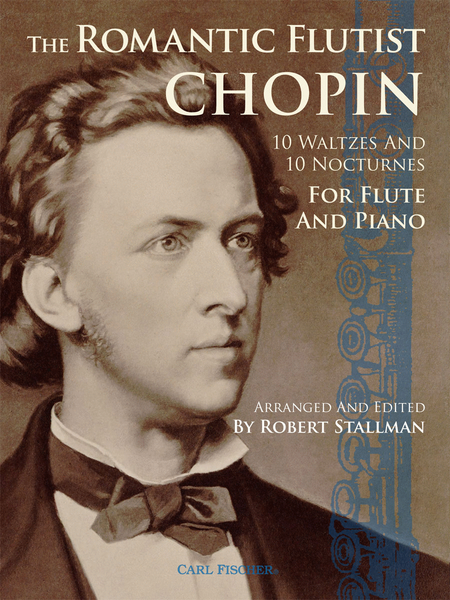The Romantic Flutist Chopin
10 Waltzes and Nocturnes for Flute and Piano
-
Ships in 1 to 2 weeks
Details
Description
SKU: CF.WF222
10 Waltzes and Nocturnes for Flute and Piano. Composed by Frederic Chopin. Edited by Robert Stallman. Arranged by Robert Stallman. Perfect Bind/SWS. Set of performance scores. With Standard notation. 128+44 pages. Carl Fischer Music #WF222. Published by Carl Fischer Music (CF.WF222).ISBN 9781491149362. UPC: 680160906864. 9 x 12 inches.
Liszt once remarked, “One should sing more at the piano…If we wereto hear one evening, on a deserted beach, the singing of a ChopinNocturne, what an emotion!” Drawing on the piano music of FrédéricChopin, world-renowned flutist Robert Stallman has created a uniquecompilation of Waltzes and Nocturnes arranged for flute and piano,providing twenty selections that invite flute players to enter intoChopin’s poetic and expressive world—an instrumental outgrowth ofthe bel canto school of singing. This marvelously prepared editionoffers pieces for enjoyment, inspiration, study and performance—awelcome addition to the scarce nineteenth-century repertoire availablefor the flutist.
the singing of a Chopin Nocturne, what an emotion! Thus Chopin’s rival pointed to the heart of Chopin’s aestheticand personal style—to create a singing instrument, imitating closely the highly expressive art and virtuosity of belcanto opera. As a teenager Chopin had heard Italian bel canto in his native Poland at the Warsaw National Theatre.The inspiration of Rossini, Bellini, Donizetti and other composers of the bel canto school shaped his improvisationsand fueled his earliest compositions. His only work for flute, the youthful Variations on a Theme from Rossini’s LaCenorentola is a case in point.While the bel canto style actually had its roots in the Italian Baroque and was cultivated during the Classicalera, by the time Chopin arrived in Paris, then the opera capital of Europe, bel canto composers and their brilliant vocalinterpreters were the rage. After his move to Paris in 1831 Chopin was seen regularly at the Paris Opera, where hebecame a devotee of the greatest singers of the age. Those who impacted him enormously included Malibran, Pasta,Grisi, Nourrit and especially Rubini, whom he held above all others as a model for pianistic declamation. Chopin alsobecame the piano teacher and close friend of the famous mezzo-soprano Pauline Viardot. Of a certain Mme Cinti-Demareau, Chopin wrote: I prefer her to Malibran. Malibran amazes you—the other ravishes you, and she does herchromatic scales better than Tulou, the famous flutist.What was this art of bel canto, and how does it relate to Chopin’s unique style? The bel canto vocal schoolespoused full but unforced tone, subtle nuance, controlled rubato, florid improvisation and bold declamation. Chopinemulated bel canto’s precepts in its many details. In the Nocturnes, Chopin’s most vocal and personal compositions,we find numerous examples—notated translations from voice to keyboard. In brief, these vocal rules pertain to thefollowing: phrasing (the long line); natural and expressive breathing (which Chopin notated in the Nocturnes with a longvertical line between the relevant notes, printed here as breath marks); the tasteful use of vocal portamento (glissandibetween expressive melodic intervals); the production of a seamless legato (all tones bound together in intervallictension), to avoid what Chopin called a pigeon hunt—a disconnected, staccato delivery; a simple and a naturalcantabile singing of the phrase; a spoken declamatory style; the use of imaginative fiorature or florid improvisationsbetween the printed melodic notes (to be tossed off lightly, in pianissimo, without any lingering or undue importance);an avoidance of all exaggerated accentuation and excessive expression; a general sense of effortless ease, as if one werecreating the piece in the moment. Paramount to the bel canto style was the use of a subtle rubato in the delivery ofthe melodic line. Rubato involves the ability to maintain a rhythmically steady accompaniment figure in the left-hand(the maître de chapelle, as Chopin called it), while letting the melodic right hand wander ever so freely against it. LikeMozart before him, Chopin was a supreme master of this art.The above is a tall order, but as flutists we are fortunate to have the possibility of imitating the human voice farmore convincingly than a pianist, who plays on a percussive instrument, where the art of pedaling and a sense of illusionare required in order to make long notes appear to sustain or crescendo. Because the flute is the closest instrument to thehuman voice, we can, with serious study, bring Chopin’s haunting Nocturnes and lilting Waltzes to life in the best belcanto tradition.I hope that both amateur and professional flutists will enjoy expanding our scant Romantic repertoire andperforming these beautiful works. As with Mozart, playing Chopin can invite us to become more sensitive musicians,while offering us unlimited inspiration.

 Share
Share